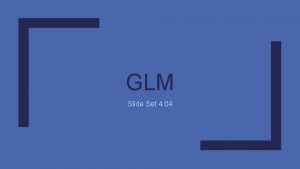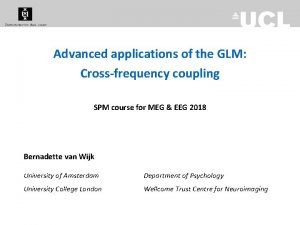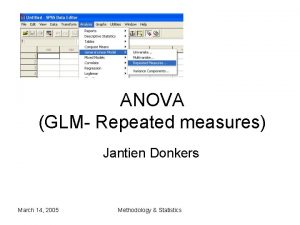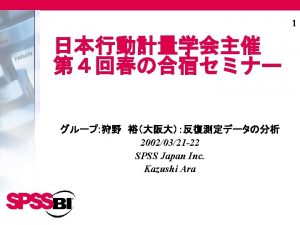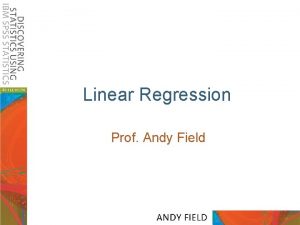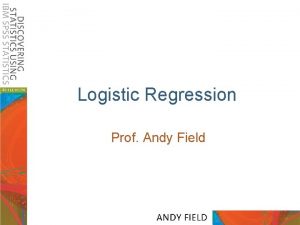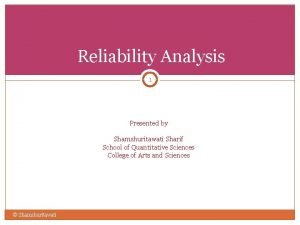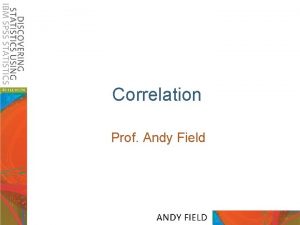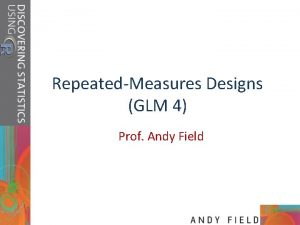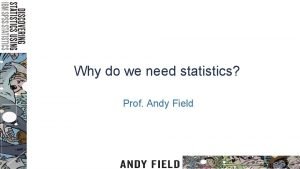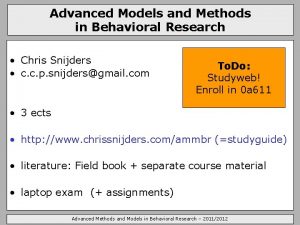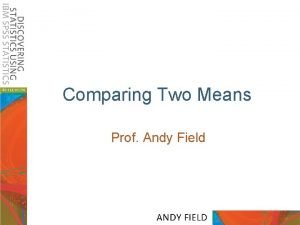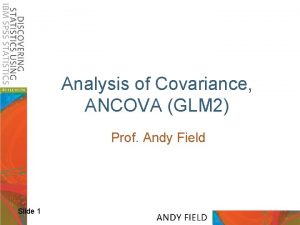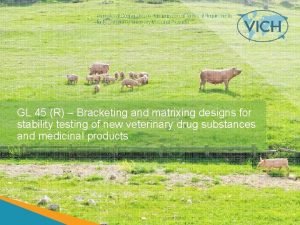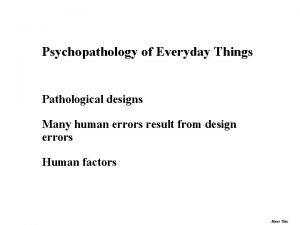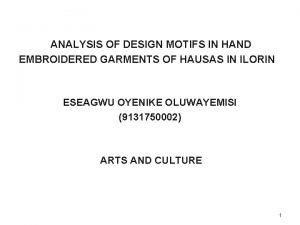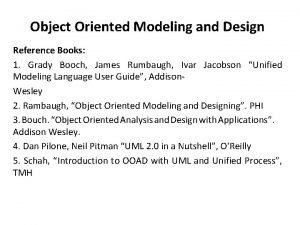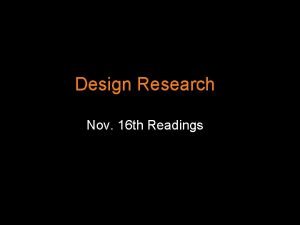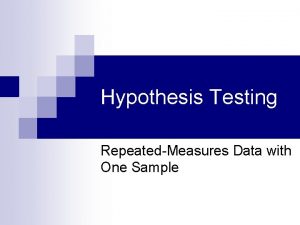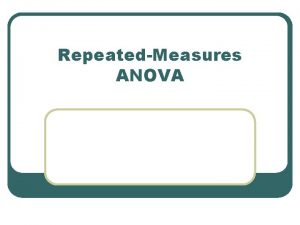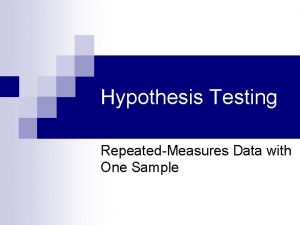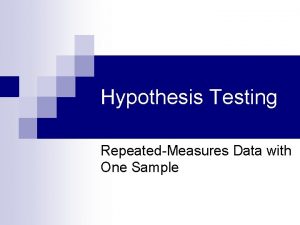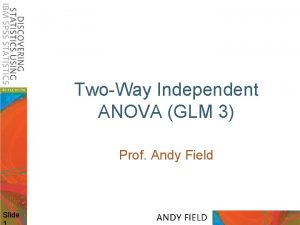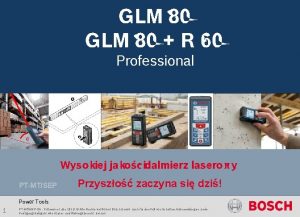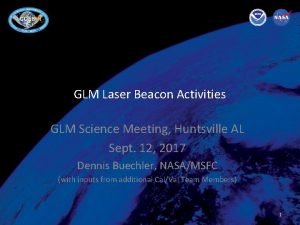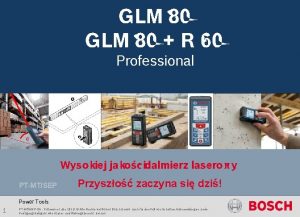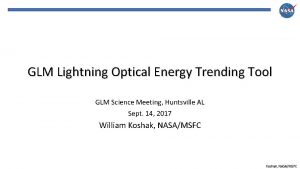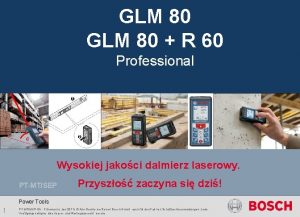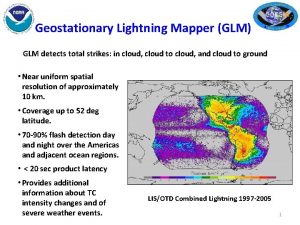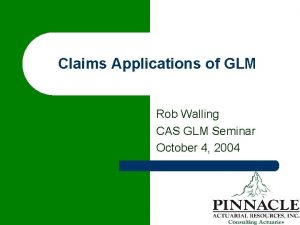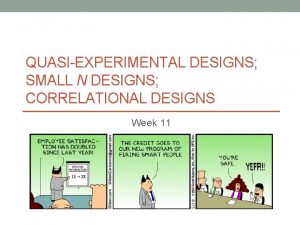RepeatedMeasures Designs GLM 4 Prof Andy Field Aims












































- Slides: 44

Repeated-Measures Designs (GLM 4) Prof. Andy Field

Aims • Rationale of repeated measures ANOVA – One- and two-way – Benefits • Partitioning variance • Statistical problems with repeatedmeasures designs – Sphericity – Overcoming these problems • Interpretation Slide 2

Benefits of Repeated Measures Designs • Sensitivity – Unsystematic variance is reduced. – More sensitive to experimental effects. • Economy – Fewer participants are needed. – But be careful of fatigue. Slide 3

An Example • Are certain bushtucker foods more revolting than others? • Four foods tasted by eight celebrities: – – Stick insect Kangaroo testicle Fish eyeball Witchetty grub • Outcome: – Time to retch (seconds) Slide 4

The Data


Problems with Analysing Repeated-Measures Designs • Same participants in all conditions – Scores across conditions correlate. – Violates assumption of independence (lecture 2). • Assumption of sphericity – Crudely put: the correlation across conditions should be the same. – Adjust degrees of freedom. Slide 7

Exploring the Data Slide 8

Exploring the Data by(long. Bush$Retch, long. Bush$Animal, stat. desc)

The Assumption of Sphericity • Basically means that the correlation between treatment levels is the same. • Actually, it assumes that variances in the differences between conditions is equal. • Measured using Mauchly’s test. – p <. 05, sphericity is violated. – p >. 05, sphericity is met. Slide 10

What is Sphericity? Slide 11 Testicle – Stick Eye – Stick Witchetty – Stick Eye – Testicle Witchetty – Testicle – Eye 1 -1 -7 -2 -6 -1 5 2 -4 -7 -4 -3 0 3 3 -4 -3 2 1 6 5 4 -2 -4 4 -2 6 8 5 -4 -3 0 1 4 3 6 -2 -1 0 1 2 1 7 -8 -3 -8 5 0 -5 8 -6 -4 -11 2 -5 -7 Variance 5. 27 4. 29 25. 70 11. 55 14. 29 26. 55

Estimates of Sphericity • Three measures: – Greenhouse–Geisser estimate – Huynh–Feldt estimate – Lower-bound estimate • Multiply df by these estimates to correct for the effect of sphericity. • G-G is conservative, and H-F liberal. Slide 12

Correcting for Sphericity df = 3, 21 Slide 13

Choosing Contrasts Partvs. Whole<-c(1, -1, 1) Testiclevs. Eye<-c(0, -1, 1, 0) Stickvs. Grub<-c(-1, 0, 0, 1) contrasts(long. Bush$Animal)<-cbind(Partvs. Whole, Testiclevs. Eye, Stickvs. Grub) Slide 14

The Easier (But Slightly Limited) Way: Repeated-Measures ANOVA bush. Model<-ez. ANOVA(data = long. Bush, dv =. (Retch), wid =. (Participant), within =. (Animal), detailed = TRUE, type = 3) • To see the output execute the model name: bush. Model

Output

Post Hoc Tests pairwise. t. test(long. Bush$Retch, long. Bush$Animal, paired = TRUE, p. adjust. method = "bonferroni")

The Slightly More Complicated Way: the Multilevel Approach • We can use lme(): bush. Model<-lme(Retch ~ Animal, random = ~1|Participant/Animal, data = long. Bush, method = "ML") • We have defined the model in exactly the same was as for aov(), we have simply added in a term that lets the model know that the variable Animal is made up of the same participants repeated multiple times across the variable Animal: (random = ~1|Participant/Animal).

The Slightly More Complicated Way: the Multilevel Approach • To test whether Animal had an overall effect, compare the model that we have just created to one in which the predictor is absent: baseline<-lme(Retch ~ 1, random = ~1|Participant/Animal, data = long. Bush, method = "ML") anova(baseline, bush. Model)

Parameter Estimates summary(bush. Model)

Post Hoc Tests • To get post hoc tests for the current data, execute: post. Hocs<-glht(bush. Model, linfct = mcp(Animal = "Tukey")) summary(post. Hocs) confint(post. Hocs)

Post Hoc Tests Output

Robust One-Way Repeated. Measures ANOVA • Needs data to be in wide format. • Get rid of participant variable: bush. Data 2<-bush. Data[, -c(1)]

Robust One-Way Repeated. Measures ANOVA rmanova(bush. Data 2) • or: rmanovab(bush. Data 2, nboot = 2000)

Output

What is Two-Way Repeated. Measures ANOVA? • Two independent variables – Two-way = 2 IVs – Three-way = 3 IVs • The same participants in all conditions – Repeated measures = ‘same participants’ – A. k. a. ‘within-subjects’ Slide 26

An Example • Field (2009): Effects of advertising on evaluations of different drink types. – IV 1 (Drink): beer, wine, water – IV 2 (Imagery): positive, negative, neutral – Dependent variable (DV): Evaluation of product, from – 100, dislike very much, to +100, like very much Slide 27

SST Variance between all participants SSR SSM Between. Participant Variance Within-Participant Variance explained by the experimental manipulations SSA B Effect of Drink Effect of Imagery Effect of Interaction SSRA SSRB SSRA B Error for Drink Slide 28 SSB Error for Imagery Error for Interaction

Getting Data into the Correct Format • Data needs to be in long format. • Can use melt() function to change data into long format: long. Attitude <-melt(attitude. Data, id = "participant", measured = c( "beerpos", "beerneg", "beerneut", "winepos", "wineneg", "wineneut", "waterpos", "waterneg", "waterneu")) • Rename columns so that we actually know what they represent by executing: names(long. Attitude)<-c("participant", "groups", "attitude") Slide 29

Getting Data into the Correct Format for the Analysis • The variable groups is a mixture of our two predictor variables (imagery and type of drink). • We need to create two variables that dissociate the type of imagery from the type of drink: – long. Attitude$drink<-gl(3, 60, labels = c("Beer", "Wine", "Water")) • We also need a variable that tells us the type of imagery that was used: long. Attitude$imagery<-gl(3, 20, 180, labels = c("Positive", "Negative", "Neutral"))

Getting Data into the Correct Format for the Analysis

Exploring Data Slide 32

Setting Contrasts

Factorial Repeated-Measures ANOVA attitude. Model<-ez. ANOVA(data = long. Attitude, dv =. (attitude), wid =. (participant), within =. (imagery, drink), type = 3, detailed = TRUE) attitude. Model Slide 34

Output

Main Effect of Drink F(2, 38) = 5. 11, p <. 05 Slide 36

Main Effect of Imagery F(2, 38) = 122. 56, p <. 001 Slide 37

The Interaction Effect (drink × imagery) F(4, 76) = 17. 15, p <. 001 Slide 38

Post Hoc Tests for the Interaction Term pairwise. t. test(long. Attitude$attitude, long. Attitude$groups, paired = TRUE, p. adjust. method = "bonferroni")

Factorial Repeated-Measures Designs as a GLM baseline<-lme(attitude ~ 1, random = ~1|participant/drink/imagery, data = long. Attitude, method = "ML") • If we want to see the overall effect of each predictor then we need to add them one at a time: – drink. Model<-update(baseline, . ~. + drink) – imagery. Model<-update(drink. Model, . ~. + imagery) – attitude. Model<-update(imagery. Model, . ~. + drink: imagery)

Factorial Repeated-Measures Designs as a GLM • To compare these models we can list them in the order in which we want them compared in the anova() function: anova(baseline, drink. Model, imagery. Model, attitude. Model)

Parameter Estimates • We can further explore the model by executing: summary(attitude. Model) • Most important, these include the parameters for the contrasts that we set for each variable.

Parameter Estimates

 Frederike petzschner
Frederike petzschner Dot product glm
Dot product glm Glm cross
Glm cross Glm repeated measures
Glm repeated measures Glm nedir
Glm nedir Anova 例題
Anova 例題 Andy field
Andy field Andy field logistic regression
Andy field logistic regression Shamshuritawati sharif
Shamshuritawati sharif Andy field
Andy field Andy field factor analysis
Andy field factor analysis Andy field
Andy field Andy field anova
Andy field anova Andy field decision tree
Andy field decision tree Andy field
Andy field Andy field
Andy field Andy field mediation
Andy field mediation Ancova spss interpretation
Ancova spss interpretation Data types and field properties
Data types and field properties Field dependent vs field independent
Field dependent vs field independent Field dependent and field independent
Field dependent and field independent Q factor of capacitor
Q factor of capacitor Difference between electric field and magnetic field
Difference between electric field and magnetic field Gauss law in magnetism
Gauss law in magnetism E field h field
E field h field Individual differences in second language learning
Individual differences in second language learning The cay chapter 10
The cay chapter 10 Types of methodologies
Types of methodologies Early american period floral design
Early american period floral design Vce english language study design
Vce english language study design Traditional organizational designs
Traditional organizational designs Solid form designs
Solid form designs Basic principles of experimental designs
Basic principles of experimental designs Fast dragster designs
Fast dragster designs Introduction of plant layout
Introduction of plant layout Bracketing and matrixing
Bracketing and matrixing Pathological design
Pathological design Within-subject design example
Within-subject design example Motif designs for hand embroidery
Motif designs for hand embroidery Quasi-experimental research designs
Quasi-experimental research designs Object oriented modeling and design books
Object oriented modeling and design books Fallout 4 intuitive designs
Fallout 4 intuitive designs The recurring aspects of designs are called design
The recurring aspects of designs are called design Notan art definition
Notan art definition The history of floral design
The history of floral design

